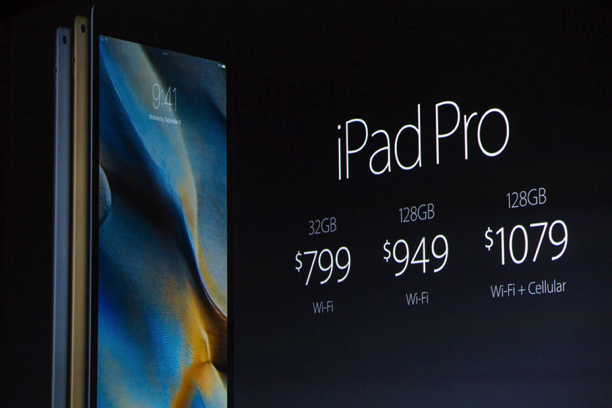Apple announced the launch of the iPad Pro this week, with early pre-orders from third party stores already sold out. While the price point and target audience will limit this new entrant from reaching iPhone or even iPad like sales figures, it will no doubt be another commercial success for Apple.
Regardless of whether it succeeds or fails (it won’t), what’s interesting is that this is the first device from Apple that is clearly targeted at enterprise users, both from a marketing and feature perspective. Tech journalists are discussing how the Cisco announcement, made at the same time as the iPad Pro, indicates Apple’s desire to target enterprise use cases with a laptop alternative or replacement. No doubt, enterprise MDM and app development platform vendors are eager to claim support for this new device at launch.

Let’s take a closer look at the iPad Pro and what impact it might have on the enterprise…
Laptop-Like Capabilities
In case you haven’t checked it out yet, the specs are way beyond what you get with existing “non-pro” iPad models:
- 12.9-inch display with a 2,732 x 2,048 resolution capable of 5.6 million pixels
- A9X chip, Apple's third generation 64-bit chip, which is 1.5 times faster than the A8X chip, 80% faster than all portable PCs on the market, and 90% faster at rendering graphics than comparable portable PCs
- A battery that can run on a single charge for 10 hours, according to Apple
- Weighs 1.57 pounds (712g) and available in gold, silver and space grey (sorry, rose gold fans)
- Available Pencil, a low-latency, pressure-sensitive stylus
- Available Smart Keyboard, an integrated cover and keyboard
Laptop-Like Price Points

The 128GB version (a minimum level of storage for any serious content creator), without LTE option, is $949. Add $99 for the must-have Pencil and $169 for the Smart Keyboard, for a total of $1,217. This price point is well into the range of a capable laptop, and slightly more expensive than the comparable, and well-regarded, Microsoft Surface Pro 4.
The iPad Pro’s Weakest Link? iOS
Apple claims the large touchscreen makes “…editing 4K video, designing presentations, running a business — easier, faster, and more engaging.” While this may be true if you compare iOS apps running on the smaller iPad versus the iPad Pro, the elephant in the room is that most, perhaps all, professional-grade content creation tools are not available for iOS, and may not be for some time, if ever.
In theory, a touch or stylus-driven screen, large and sharp enough to display side-by-side apps, would be ideal for content creation tasks and workflow between applications like Photoshop and Illustrator, or ZBrush and 3D Studio, or AutoCad and PowerPoint, or After Effects and Avid Media. However, none of those professional applications run on iOS, and it is unlikely they ever will.
Even if some of these companies did decide to take on the huge task of re-implementing these behemoth applications as iOS apps, questions remain around the business model: would users accustomed to paying $4.99 for apps in the App Store be open to $1,000+ price points, and would these publishers be willing to share 30% of their revenue with Apple? Sure, there may be companion iOS apps that complement their full-strength siblings, but that’s not what the iPad Pro is about, neither in terms of its capability nor its price point.

Another issue is that content creation is typically a file-centric process. You save, open, copy, delete, export, import, archive and perform other tasks with files created in all those professional applications you use every day in the workplace. File management is an inherent part of the enterprise content creation process. There is an entire industry built around enterprise content management, and even MDM vendors tout their file management capabilities. iOS lacks these fundamental file access features – it was never designed to be an operating system built around file management.
The reality is that with the launch of iPad Pro, Apple created a device that is on a collision course with the Macbook Pro in terms of enterprise usage, with the operating system as the only differentiator. The lack of iOS' ability to run full-strength enterprise apps, or if you prefer, the lack of full-strength enterprise applications for iOS, will ultimately limit the iPad Pro to a smaller segment of enterprise users. Maybe that’s exactly what Apple wants, for now.
With the launch of the iPad Pro and new Apple TV, Apple is at an interesting crossroads where they now have multiple viable consumer and enterprise channels, but a fragmented operating system strategy across their device landscape. At some point, this may have a negative impact on the Apple ecosystem. Interestingly, Microsoft has made attempts to solve this same problem with Windows 10 across the corresponding Windows device ecosystem.
Our take on the iPad Pro? Great promise, especially for creative artists and large-format enterprise content consumption (viewing x-rays, cad drawings, documents, presentations, etc.), but it will struggle as a true laptop replacement until it runs OSX.